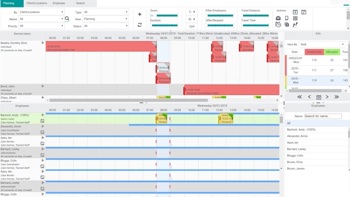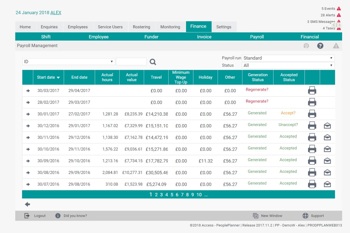What is a Domiciliary Care Rostering System?
Care rostering systems are usually the first bit of care software that a domiciliary care business implements.
Once you get more than a handful of care workers, scheduling care visits becomes enormously time consuming.
If you work in domiciliary care, you will know how hard it can be to keep on top of everything and provide the best care to clients, while ensuring the business has enough staff and is prepared for inspections.
- Why is a domiciliary care rostering system important?
- What is Domiciliary Care?
- Types of domiciliary care services
- What Are Home Care Rostering Systems?
- How Care Rostering Systems Work
- Care Rostering Systems Components
- Benefits of Using Domiciliary Care Rostering Systems
- Choose the Best Rostering System for Domiciliary Care
- Our Care Rostering System

Why is a domiciliary care rostering system important?
If you are new to the care sector, or new to using care software, you will be looking for an honest breakdown of what a care rostering system is.
The Access Group’s care rostering system Access Care Rostering, first came to market in 2006 and has been continuously developed since, so we’ve got a good idea of the different care rostering systems, what they do and how they can benefit domiciliary care providers.
All care rostering systems are different, but after reading this article you should understand exactly what a care rostering system is at its core, the general features and some of the key ways care rostering systems differ.
We will also explore the main ways care rostering systems benefit domiciliary care providers.

What is Domiciliary Care?
Domiciliary care is a form of care that is provided in an individual’s home. It’s sometimes referred to as ‘home care’ or ‘care at home.’
Caregivers in this role will either visit people or live in their homes, which allows them to be on hand when service users need their support.
If a person needs help with personal care or practical tasks but wants to remain out of a care home, then a domiciliary carer is their best option.

Types of domiciliary care services
There are several different types of domiciliary care services, including:
- Companionship care – often begins informally and can consist of small and simple tasks such as going over to someone’s home for a chat over a cup of tea.
- Housing support – this requires a carer to visit their client a few times a week and they will help with tasks like paying bills, reading letters and mail, and other tasks to maintain the home.
- Domiciliary care with two carers – if someone needs help and support when it comes to getting out of bed or walking, then two carers are often better than one.
- Multiple care visits per day – often consisting of a morning, midday and evening visit, this is the best option for those who need someone to help them throughout the day.
- Live-in care – a trained carer may move into someone’s home to provide care and support when the person needs it. This is good for people who sleep well throughout the night.
- 24-hour care – if a client wakes up multiple times throughout the night, then a 24-hour care plan may be best, as carers who can remain awake throughout the night will be available.
- Nursing domiciliary care – when a client requires medical attention, like injections, oxygen assistance or other nursing help, speciality nursing care may be provided.

What Are Home Care Rostering Systems?
Care rostering systems are a form of software that has been designed to help with scheduling client visits, to ensure every person has been seen to and cared for.
They replace and improve many manual processes associated not just with scheduling care visits. For example, some can also manage those HR and financial processes that are typical for a home care agency.
If you have a home care agency, implementing a rostering system will allow you to create and manage schedules easily and efficiently, while allocating the right staff to each visit and, depending on the rostering system, accurately generate payroll information (including using variable rates) and billing information for local authorities and private funders alike.

How Care Rostering Systems Work
Rostering systems designed for those working in domiciliary care provide care staff with an easy-to-use platform that is both simple and effective.
Care rostering systems all differ somewhat in their functionality, for example, some will be able to instantly calculate all your care workers’ pay based on actual hours worked, including travel time and other factors.
Others will be less sophisticated, be less able to handle complex situations and/or be less customisable or flexible. That said, here is a general overview of what you could expect from a care rostering system.
‘Care coordinators’, or whoever is responsible for scheduling the visits, use the software interface to build digital care schedules in advance, sometimes templating schedules in blocks of weeks.

Care Rostering Systems Components
They can easily see who is available for each visit and allocate them to it. Depending on the rostering system you use, factors such as skills and qualifications, languages spoken, distance from previous visits, service user preferences and a range of other relevant factors can all be used to pluck out the best person to complete the visit and allocate them to it.
Care rostering systems usually have an Electronic Call Monitoring component, to record when staff start and complete each visit, at each location. This information then feeds directly into the rostering system to flag anomalies.
Care rostering systems differ, but many use some form of messaging to notify staff, for example if a visit they were allocated to has been cancelled or rescheduled.
Again, depending on how ‘functionally rich’ the rostering system is, it may include invoice generation, payroll reconciliation functionality, travel and route planning functionality and employee management tools like expenses, recruitment, holiday, sickness and more.
Benefits of Using Domiciliary Care Rostering Systems
Choose the Best Rostering System for Domiciliary Care
At its core, a rostering system is about scheduling care workers to visits, efficiently and reliably. As we’ve discussed some rostering systems do this better than others. Some are more flexible, or easy to use, or handle complex or unusual situations that other systems don’t.
Your system may help you find the right person for each visit, or with a more basic system this may still be something the coordinator has to tackle themselves.
Features emanate out from this core rostering functionality, to cover staff and employee management, paying, billing and more. This is where the divergence from one care rostering system to another really start to show.
Our Care Rostering System
Our own care rostering system, Access Care Rostering is the most widely used by UK domiciliary care providers. It is functionally richer than most other care rostering systems we’ve seen being used, and is a part of our ‘ecosystem’ of care products, including compliance tools, integrated electronic call monitoring, electronic care planning and more




